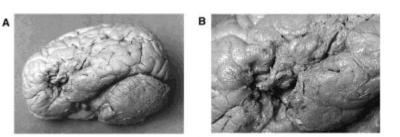Answer: The Wernicke-Geschwind model is an early model for understanding how speech is produced in humans.
From http://www.yalescientific.org/2014/12/uncharted-waters-in-dyslexia-research/
Speech production and comprehension is a complex process that involves several parts of the nervous system, from the higher cognition and processing centers to the nerves that innervate the muscles of the mouth and tongue. The Wernicke-Geschwind model is a historical model developed to understand the pathway in the brain responsible for auditory and visual cognition and speech responding.
The Wernicke-Geschwind model concerns itself largely with the connections between specific areas of the brain. It holds that certain areas communicate with others in order to extract information about the meanings of words, before that information is passed to the speech production and motor areas of the brain.
There are two main functions that the Wernicke-Geschwind model explores: comprehension and responding to the written word and comprehension and responding to spoken language.
According to the model, information from the written word first arrives from the eyes into the occipital lobe in the primary visual cortex. From here, the information is passed to the angular gyrus, and then onto Wernicke’s area. The arcuate fasciculus is a white matter tract that then sends information from here into Broca’s area. Finally, information from Broca’s area is passed to the motor cortex, which can send an outward motor command.
The model also explains how comprehension of and responding to auditory communication works. Information enters the brain through the ear and initially is processed in the primary auditory cortex. From here, that coded information is passed into Wernicke’s area. Making a motor response at this stage is the same as in the case of responding to visual input: The arcuate fasciculus passes that information rostrally into Broca’s area, then dorsally into the motor cortex for eliciting the motor response.
The Wernicke-Geschwind model is largely outdated due to inconsistencies in human case studies where an injury doesn't cause the expected deficiency based on the model. On the other hand, sometimes injuries outside of the regions identified in the model can cause various forms of aphasia, the difficulty in speech production.




